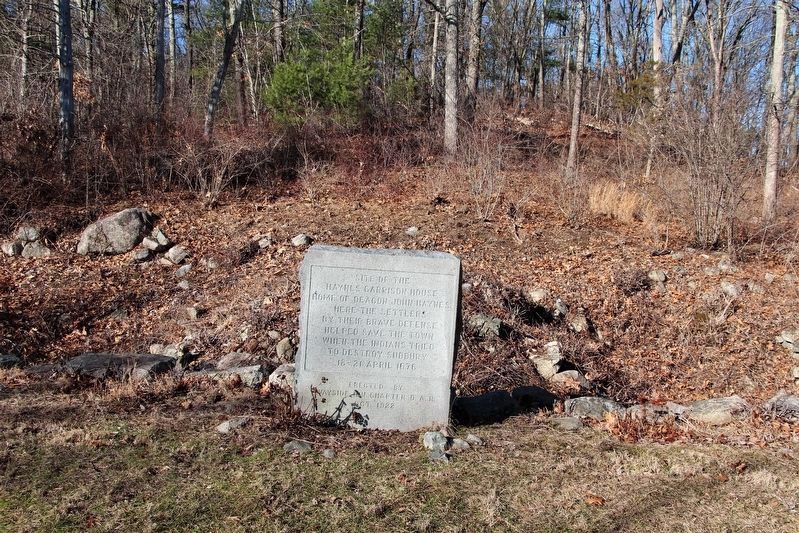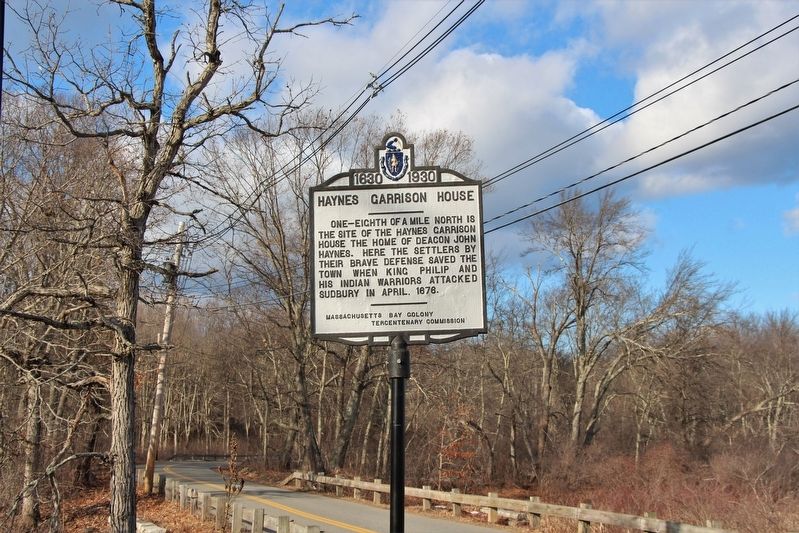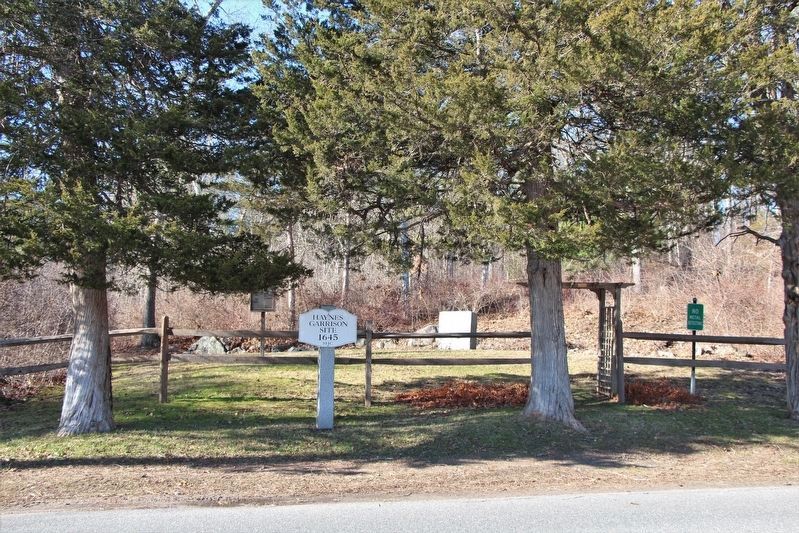Sudbury in Middlesex County, Massachusetts — The American Northeast (New England)
Haynes Garrison House
Inscription.
One-Eighth of a mile north is the site of the Haynes Garrison House the home of Deacon John Haynes. Here the settlers by their brave defense saved the town when King Philip and his Indian warriors attacked Sudbury in April, 1676.
Erected 1930 by Massachusetts Bay Colony Tercentenary Commission.
Topics and series. This historical marker is listed in these topic lists: Colonial Era • Notable Events • War, French and Indian. In addition, it is included in the Daughters of the American Revolution series list. A significant historical month for this entry is April 1676.
Location. 42° 22.55′ N, 71° 23.317′ W. Marker is in Sudbury, Massachusetts, in Middlesex County. Marker is at the intersection of Water Row and Old Sudbury Road (State Route 27), on the left when traveling north on Water Row. The Marker is 0.1 (one tenth of a mile) south of the small parking area on Water Row for King Philip Woods in Sudbury, MA. King Philip Woods is part of the Town of Sudbury Conservation lands. Touch for map. Marker is in this post office area: Sudbury MA 01776, United States of America. Touch for directions.
Other nearby markers. At least 8 other markers are within 4 miles of this marker, measured as the crow flies. Sudbury (approx. 0.9 miles away); The Goodnow Garrison House (approx. one mile away); First Town Center (approx. one mile away); Hop Brook Mill (approx. 1.7 miles away); Sudbury Fight (approx. 1.7 miles away); Gen. Henry Knox Trail (approx. 2.4 miles away); Knox Trail (approx. 2.6 miles away); Garden in the Woods (approx. 3.1 miles away). Touch for a list and map of all markers in Sudbury.
More about this marker. On April 21, 1676, Sudbury, Lancaster, and Marlborough were burned to the ground by marauding Native Americans under the command of the Wampanoag Chief, King Philip. A feeling of impending crisis sent the Sudbury settlers to their six garrison houses. By 6:00 a.m. that fateful day, a force of 1,000 to 1,500 Native Americans under King Philip infiltrated the woods, burned the isolated farmhouses, and attacked the garrisons. None of the garrison houses remain today, but the foundation of the Haynes Garrison House can be seen on the adjacent town-owned parcel. It was to the Haynes Garrison House that the two Concord survivors of the Native American massacre at the Four-Arch Bridge (at the Sudbury River in Wayland) fled for refuge. Here, the defenders showed such courage and fierce determination to defend their homes, that by 1:00 p.m., the Native Americans gave up and faded
into the woods. Perhaps the increasing frequency of musket fire from the direction of Green Hill drew the discouraged Native Americans over Goodman Hill to the main engagement. There, King Philip and his warriors finally overwhelmed the colonials that afternoon but failed to consolidate their victory and began the slow descent into final defeat of the Native American peoples in southern New England. - Town of Sudbury Conservation Commission

Photographed By Stephen St. Denis, January 13, 2020
3. Haynes Garrison House Marker
Daughters of the American Revolution Monument at the site of the Haynes Garrison House foundation.
Site of the
Haynes Garrison House
Home of deacon John haynes
Here the settlers
by their brave defense
helped to save the town
when the Indians tried
to destroy Sudbury
18 — 21 April 1676
Erected by
Wayside Inn Chapter D.A.R.
October, 1922
Haynes Garrison House
Home of deacon John haynes
Here the settlers
by their brave defense
helped to save the town
when the Indians tried
to destroy Sudbury
18 — 21 April 1676
Erected by
Wayside Inn Chapter D.A.R.
October, 1922
Credits. This page was last revised on January 13, 2020. It was originally submitted on January 9, 2020, by Stephen St. Denis of Worcester, Massachusetts. This page has been viewed 1,610 times since then and 114 times this year. Photos: 1. submitted on January 9, 2020, by Stephen St. Denis of Worcester, Massachusetts. 2, 3. submitted on January 12, 2020, by Stephen St. Denis of Worcester, Massachusetts. • Michael Herrick was the editor who published this page.

